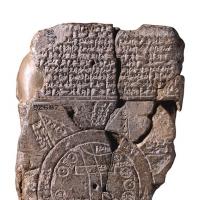Arc de Triomphe carrousel. carousel square carousel square
Carrousel Square (Place du Carrousel) is located in the first arrondissement of Paris between the Louvre and the Tuileries Garden.
A look into the past
Place Carruzel appeared on the map of Paris in 1662. It was created by order of King Louis XIV to hold celebrations on the occasion of the birth of the heir. the program of which included a demonstration of the skills of cavalrymen during horse dressage - carruzels. Until that time, in the wasteland between the Tuileries Palace and the wall of Charles V, since 1600 there was the palace of the Duchess of Montpensier, demolished in 1655.
During the Great french revolution end of the 18th century Place Carruzel became the site of public executions. For several years in these turbulent days, it was renamed Brotherhood Square. A guillotine was installed on it, on which dozens of people were executed, including the writer J. Cazotte and the minister of the government of Louis XVI A. de Laporte.
AT early XIX in. under Napoleon I, the area was expanded after the demolition of old houses. A few decades later, during the Second Empire, under the reign of Napoleon III, the square became even more spacious.
During the Paris Commune of 1871, the Tuileries Palace, built for Catherine de Medici, was set on fire by the rebels. The fire almost completely destroyed it, and after the suppression of the uprising, the palace was not restored, and in 1883 the boundaries of the square were again pushed to the west.
The architectural ensemble of the square
On the east side of the square is the Royal Palace Museum (Musée du Louvre), in front of which in the courtyard of Napoleon is the famous glass pyramid designed by architect Yo Ming Pei. On the north and south sides, it is also partially framed by the two wings of the royal palace Denon and Richelieu. 
In the center of the square since 1989, in the middle of a round area with hedges of bushes, there is an inverted one (La Pyramide inversée du Louvre), most of which is hidden underground. This structure, designed by Yo Ming Pei, with sides measuring 16 m and a height of 7 m, weighs about 160 tons. 
In 1807-1809, to commemorate the French victory at Austerlitz, Carruzel Square was erected. Its project was jointly developed by the architects C. Persier and P. Fontaine. The bas-reliefs and mosaics placed on its walls and vault illustrate the events of the military campaign of 1805. One of the main images is the surrender scene in Ulm. 
Behind the arch on the west side, the Carruzel Garden (jardin Сarruzel) adjoins the square. It is located on a small hill and is separated from the garden by Avenue Du General Lemonnier. The Carruzel Garden was laid out on the site of the demolished Tuileries Palace in 1883. In 1964, 20 statues by the sculptor A. Mayol were installed in the garden: Pain, Summer, Flora, Night, Pomona and many others.
Between the museum and the Arc de Triomphe on the square, there are two statues in the style of classicism, made by the sculptor A-F. Gerard. The two female figures symbolize the history of France and its military victories. 
There is a large shopping underground center near Carruzel Square
Category: Paris
Not everyone may know that there are as many as five triumphal arches in the capital of France. The most famous Arc de Triomphe is the one in Charles de Gaulle Square. Two more are located on the same line with it: this is the Grand Arch of Defense in the business district of the city and the Arc de Triomphe on Carruzel Square, stretching between the famous Louvre and the Tuileries Garden. The arch is clearly visible from the south wing of the Louvre - it is visible on the left. Looking at it, you involuntarily think: how did this majestic monument appear in Paris?
In the image and likeness of ancient Roman arches
Napoleon Bonaparte, who won the decisive battle with the armies of the Russian and Austrian empires near Austerlitz in Moravia in December 1805, decided to perpetuate his brilliant victory for history. To this end, he ordered Charles Percier and Pierre Fontaine to develop a project for a monumental structure that would simultaneously serve as the entrance gate to the Tuileries Palace, the residence of the emperor. The architects took the three-span arch of Constantine in Rome, built in 315, as a model and enthusiastically set to work. The construction lasted from 1807 to 1809, and as a result, a 19-meter three-span arch appeared to the admiring eyes of the Parisians. The building was crowned with a quadriga of St. Mark, taken from Venice, made of gilded bronze.
The triumphal arch on Carruzel Square, made in the Empire style, is very reminiscent of the triumphal arches of the ancient Roman era. It is decorated with eight columns of the Corinthian order - one of the three main architectural orders. The columns are made of white and red marble, each of them has a statue of a soldier of the Napoleonic army. These are cuirassier, cavalry grenadier, dragoon, cavalryman, infantry grenadier, gunner, carabinieri and sapper. Each warrior has his own uniform and ... his own sculptor (the authors of the statues, respectively, are Tone, Shinar, Corbet, Foku, Dardel, Bridan, Mouton and Dumont). The bas-reliefs depict scenes of military battles. They were personally selected by Vivant Denon, director of the Napoleon I Museum in the Louvre (one of the departments of the modern Louvre Museum bears the name of this figure).

Bas-reliefs of Clodion and symbols of heraldry
The author of the bas-reliefs with plots of military battles is the French sculptor Clodion ( real name Michel). They depict the battle of Austerlitz we have already mentioned, the triumphal entry of Bonaparte into Munich and Vienna, as well as the fall of Ulm, the city in Germany, into which the emperor in 1805 lured the Austrian army under the command of General Mack and forced her to surrender. In addition, the conclusion of the Treaty of Pressburg in 1805 between France and Austria, according to which Napoleon acquired a number of Italian lands, and the congress in Tilsit (now the city of Sovetsk in the Kaliningrad region of the Russian Federation) are immortalized on the bas-reliefs. Here, in 1807, a peace treaty was concluded between Napoleon I and Alexander I, according to which Russia recognized all the conquests of Bonaparte.

The Arc de Triomphe on Carruzel Square is also decorated with the heraldic symbols of the Kingdom of Italy (a state in Northern Italy during the time of Napoleon) and the Bonapartist French Empire itself. After France returned to Venice the quadriga of Saint Mark, which crowned the arch, in 1815, its place was taken by the sculptural composition of Francois Joseph Bosio and Francois-Frédéric Lemot, allegorically depicting the triumph of the Bourbons. Since 1871, the arch has ceased to be the entrance gate to the Tuileries Palace, since the palace itself was gone: it was burned by the French revolutionaries. However, this did not prevent the monument from organically fitting into the 9-kilometer historical axis, which includes the Place de la Concorde, the Champs Elysees, the Arc de Triomphe on the Place de Gaulle and the Grand Arch of Defense.
This pyramid, built of glass, aluminum and steel, located on the territory of the Louvre Palace Museum, the construction of which lasted for five years, was inaugurated at the end of March 1989. Having almost 22 meters in height and occupying an area...
The French (and not only) have a not very honest, but spectacular and effective method"splurge" potential partners, buyers, clients. They rent a mailbox for a few hundred euros - on the Champs-Élysées. Epi...
Going to get acquainted with the numerous sights of the French capital, you should, first of all, turn your attention to the historical center of the city, more precisely, its oldest part - the island of Cité (Île de la Cité). This is where you can't...
... Dimmed light. Noise falls in the hall. And a moment before the curtain, before the whirlwind and ecstasy of the dance, a moment before someone's new love, the dusk in box No. 5 thickens and darkens ... Eric has come again. He came for her. But time turned out to be stronger than all forces in the world ...
The Seine begins in Paris. Not symbolically, but literally. The key of the river "opens" the land in the spruce Parisian forest and rushes on its way - from Paris - to Paris - to the English Channel, to the ocean ... 290 kilometers from the capital of France, on the Burgundian Langres plateau (Langres ...
The Arch on Carruzel Square is an architectural structure in the Empire style, glorifying the victories of the great commander. The main gate to the Tuileries and the historical value of Paris.
A historical object and a beautiful landmark of Paris - the arch on Carruzel Square, should have served as the main gate to, long before it was burned. In 1802, during the Peace of Amiens, a decision was made to build a building separating the Louvre and the Tuileries Palace.
The arch acquired its architectural form thanks to the desire of Napoleon Bonaparte to perpetuate the power of his army in the monument. So, in 1808, a celebration was held on the occasion of the opening in honor of Napoleon's victory in the battle of Austerlitz. The place was not chosen by chance - at that distant time, equestrian competitions of the military army (“carrousels”) were held on the square, the arch was supposed to praise the prowess and honor of the French and serve as a memorable reminder to raise their military spirit.
The creators of the historical building were two Frenchmen - Charles Percier and Pierre Fontaine. This is the only case when other people's ideas of architectural thought were taken as a basis - the famous arch in Carruzel Square repeats the shape of the triumphal arch in Rome. The famous chariot decorating the top Napoleon took out of Venice during his next campaign. After the abdication of the emperor from the throne, the quadriga was returned to its original place, and instead of it, an improved copy was installed, made according to the project of F.Zh. Bosier. The new sculptural group consisted of four horses and two statues of Victory on the sides, and at the head of the chariot stood the figure of the World.
Arc de Triomphe at Place Carruzel in Paris
Architectural component of the object
The 19-meter arch on Carruzel Square delights with its antique forms. In the era of the creation of the historical heritage site, antiquity was in vogue and it was decorated with marble Corinthian columns with statues of soldiers of the French army. The marble bas-reliefs of the arch are decorated with images of the military battles of the great commander - the battle of Austerlitz, the battle of Ulm, the entry of Napoleon's army into Vienna, the conclusion of a peace treaty in Tilsit. The triumphal arch was decorated with bas-reliefs and heraldry applied to them - and Italy. The symbols of the Kingdom of Italy, like the Venetian quadriga, did not appear on the monumental structure by accident - the French army conquered its northern territories during the reign of Napoleon.
Expert opinion
Knyazeva Victoria
Guide to Paris and France
Ask an expertIt is noteworthy that initially the quadriga was supposed to be crowned with a statue of Napoleon himself, but the commander abandoned such an idea, saying that the arch should glorify his army, and not his excellency.
Arc de Triomphe today
Today, the object of historical heritage serves as a kind of start for a walk along the famous royal axis of Paris. Bypassing the arch, the traveler will enter the Tuileries Garden, then the route rests on the Louvre - the magnificent palace of the French kings. Thousands of tourists come every year to admire the historical heritage of France and enjoy its sights.
Louvre Museum
The arch located on Carruzel Square deserves special attention - passing through it you can get not only to the Louvre and Tuileries, but also walk along the Champs Elysees, wander around the Place de la Concorde, and also reach the main Arc de Triomphe. Paris is rich in architectural structures - five triumphal arches have been erected in the city. Each of them carries an important historical value and can tell the world about many events of past centuries.
In turn, the Venetians also stole the sculpture from the Byzantines, this quadriga adorned the entrance to Constantinople (modern). She was taken out in the 13th century, during the 4th crusade, after the sack of the Byzantine capital.
The architectural project was entrusted to the leading specialists of the time, Percier and Fontaine, who, without thinking twice, built an exact copy of the arch of Septimius Severus in Rome from this Parisian landmark.
For the first time in its history, its architects did not create something new, even if based on the classics, but reproduced someone else's masterpiece.
The monument adorned the entrance to the Tuileries Palace, then it housed the residence of the emperor. (Later, during the Comunna, the palace was burned to the ground, only two wings survived, today it is the right and left wings of the museum).
Sasha Mitrahovich 30.11.2015 16:39

FROM reverse side figures denote grenadiers, infantrymen, gunners and sappers. Behind them is written: “At the behest of the victorious Austerlitz, the German Empire collapses, the Confederation of the Rhine is born, the Bavarian and Westphalian kingdoms are created, Venice is attached to the Iron Crown, all Italy adopts the laws of its liberator.”
The inscription on the south side of the arch from the Seine side reads: "Glory great army, the winner near Austerlitz and in Moravia! The second of December 1805 is the anniversary of Napoleon's coronation”, and from the north: “Lord of the states of his enemy, Napoleon returns them to him. He signs peace on December 27, 1805 in the capital of Hungary, occupied by a victorious army.
Sasha Mitrahovich 24.12.2015 11:05

Description
In the capital of France, Paris, on Carruzel Square, there is a triumphal arch built in the 19th century by order of Napoleon to commemorate his military achievements.

For the first time in the history of France, the architects did not create anything new, even if based on the classics. They practically copied someone else's masterpiece, the arch of Septimius Severus, the Roman emperor of the late II - early III centuries.
The skill of the architects was enough to reproduce someone else's work, but not enough to demonstrate their own taste. The arch, overloaded with bas-reliefs, rather testifies to their ability to decorate furniture and interiors than to the ability to create masterpieces worthy of the center of Paris. However, for two hundred years, the Carousel arch has firmly grown into the surrounding landscape and has become an integral part of it.
Under Napoleon, she was crowned with four horses taken from St. Mark's Cathedral in Venice after the fall of the Venetian Republic. In this story, one can see a kind of historical justice. The famous quadriga, presumably the work of Phidias or Lysippus, was stolen by the Venetians during the robbery of Constantinople by the Crusaders in 1204.
However, after the abdication of Napoleon, the horses had to be returned to Venice. Now they are hidden under the roof of the local cathedral on the top floor, and copies have taken their former place on the facade.
Arch Carruzel is crowned by another copy, improved. The wagon is driven by the symbolic figure of Peace, and flanked by gilded statues of Victory. Everything together is called to glorify the Restoration - the restoration of the Bourbons on the French throne. Nevertheless, bas-reliefs and inscriptions in honor of Napoleon's victories survived under the Bourbons.
Eight soldiers, reminiscent of Lermontov's lines: "lancers with colorful badges, dragoons with horse tails" - depict the kind of Napoleonic troops. From the side of the Louvre, from left to right, are a cuirassier, a dragoon, a cavalryman and a carabinieri. The inscription above them reads: “The French army that landed at Boulogne threatened England. Then a third coalition is formed on the continent. The French rush from the ocean to the Danube, Bavaria is liberated, the Austrian army is captured in Ulm. Napoleon enters Vienna and wins at Austerlitz. In less than a hundred days, the coalition is disbanding.”
On the opposite side are a grenadier, an infantryman, a gunner and a sapper. Behind them is written: “At the behest of the victorious Austerlitz, the German Empire collapses, the Confederation of the Rhine is born, the Bavarian and Westphalian kingdoms are created, Venice is attached to the Iron Crown, all Italy adopts the laws of its liberator.”
Two more inscriptions are carved on the narrow side facades of the arch. On the south, facing the Seine, it is written: “Glory to the great army, the winner at Austerlitz and in Moravia! The second of December 1805 is the anniversary of the coronation of Napoleon.” On the north: “Lord of the states of his enemy, Napoleon returns them to him. He signs peace on December 27, 1805 in the capital of Hungary, occupied by a victorious army.
Today, the Carruzel arch stands alone almost in an open field, and at one time served as a solemn frame for the main entrance to the Tuileries Palace, which the emperor chose as his residence.



